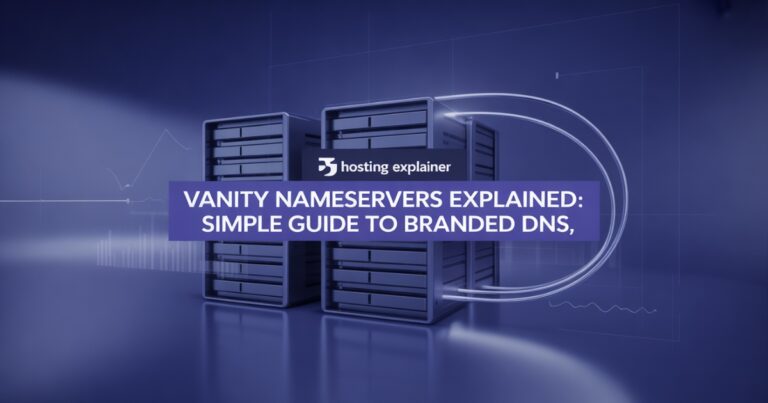Glue Records in DNS: Simple Guide to Set Them Up Right
When you first start managing domains, some DNS terms can feel confusing. Glue records are one of those. I still remember when I set up custom nameservers for the first time. Everything looked correct, yet the site refused to load. After hours of digging, the cause was simple missing glue records.
If you’ve ever hosted your own nameservers or plan to, this guide will save you that headache. I’ll explain what glue records are, why they matter, when you need them, and how to set them up the right way.

What Are Glue Records in DNS?
A glue record is a small piece of DNS data that connects a domain name to the IP address of its nameserver. It acts as a shortcut that stops DNS from getting stuck when your domain’s nameserver is part of the same domain.
For example, if your domain is mydomain.com and your nameserver is ns1.mydomain.com, the DNS resolver needs an IP address to find ns1.mydomain.com. But that address is stored inside the same zone it’s trying to reach. Without a glue record, the lookup never finishes, it loops endlessly.
A glue record solves this by storing the nameserver’s IP address at the registrar level (the parent zone). When a resolver asks where to find your site, the glue record gives it a direct route.
A Quick Comparison
Here’s a simple side-by-side look at how glue records affect your domain’s performance and reliability.
| Scenario | Without Glue Record | With Glue Record |
| Domain Resolution | Stuck in a loop | Loads immediately |
| Lookup Time | Long | Short |
| Stability | Unrealiable | Consistent |
| User Experience | Error | Smooth access |
As you can see, adding glue records makes resolution faster, smoother, and far more stable for users.
Why Glue Records Matter for Domain Stability
Glue records may look small, but they have a big impact. They prevent DNS lookup failures and keep your site reachable.
If you skip them, your domain might vanish for hours even though your web server is fine. That downtime can confuse visitors, hurt your search rankings, and even damage your brand’s trust.
DNS is like the backbone of your website. If glue records are missing, that backbone can bend under pressure. I’ve seen business sites disappear from search results for a day simply because their nameservers weren’t linked correctly. Adding glue records once can protect you from those silent failures.
When Do You Need to Create Glue Records?
You only need to glue records in certain cases. Knowing when to create them saves time and avoids clutter in your DNS setup.
You need glue records if:
- You’re hosting your own nameservers, like ns1.yourdomain.com.
- You’ve built a custom DNS setup or use private servers.
- You’re moving to a new registrar, and your domain manages its own DNS.
You don’t need to glue records if:
- You use third-party nameservers such as ns1.hostingprovider.com.
- Your DNS hosting and domain registrar are managed by the same company that already handles glue automatically.
If you’re unsure, a quick test helps. Try running a DNS check using a tool like dig +trace yourdomain.com. If the lookup fails to resolve your nameserver IP, glue records are likely missing.
How to Set Up Glue Records
Now that we know why glue records are essential, let’s go through how to set them up. The process is similar across registrars but may use slightly different labels.
Step 1: Log in to Your Domain Registrar
Sign in to the registrar that manages your domain. You’ll usually find DNS settings under a “Domain” or “Advanced DNS” tab.
Step 2: Find Glue Record or Host Name Section
Look for an option like “Host Names,” “Register Nameserver,” or “Glue Record.” Not all registrars call it the same thing, but they serve the same purpose.
Step 3: Add Your Hostname
Enter the hostname of your nameserver. For example, ns1.mydomain.com.
Step 4: Enter the IP Address
Add the server’s IP address (IPv4 or IPv6). If your server has both, you can create one glue record for each version.
Step 5: Save and Wait for Propagation
Once saved, DNS propagation can take a few hours. During that time, your site might briefly be unreachable, which is normal.
If your registrar allows you to verify the update, check that the IP appears next to the hostname in your DNS list.
Registrar Examples
| Registrar | Path | Notes |
| GoDaddy | Domain → Host Names | Propagation can take 24 hours |
| Namecheap | Advanced DNS → Personal DNS Server | Quick and simple |
| Cloudflare Registrar | DNS → Custom Nameservers | Add A records manually |
This step varies slightly depending on the company, but the logic is always the same.
Glue Record Configuration Example
Let’s walk through a working example.
- Domain: mydomain.com
- Nameserver: ns1.mydomain.com
- IP Address: 192.0.2.1
When you create a glue record, you’re telling the parent zone, “The nameserver ns1.mydomain.com lives at 192.0.2.1.”
Now, when someone types mydomain.com into a browser, the resolver knows exactly where to go, no loops, no delays. This record lives at the registry level, not just in your DNS zone, which is why setting it correctly is vital.
Common Mistakes and How to Fix Them
Even a small typo can break a DNS setup. Here are some mistakes I’ve seen and how to avoid them.
- Wrong IP Address: Double-check your entries before saving. A single incorrect digit makes the GLUE record useless.
- Typos in Hostname: If your server is ns1.mydomain.com, make sure you don’t type n1 or forget a dot.
- Skipping IPv6: If your hosting provider gives both IPv4 and IPv6, include both for full compatibility.
- Unsupported TLDs: Some registrars limit glue record creation for certain extensions. Contact support if it’s not visible.
- Forgetting to Update After a Server Move: When your server IP changes, you must update glue records. Otherwise, your nameservers still point to the old address.
Test with dig +trace yourdomain.com or online tools like DNS Checker. If the output lists your nameserver IP under the parent zone, your glue record is active.
Glue Records vs. A Records: What’s the Difference?
People often mix up GLUE records and A records because both connect names to IPs. The difference lies in where they work.
- • An A Record maps your domain to an IP (like a phonebook entry).
- A glue record connects your nameserver to an IP (like directions to find that phonebook).
| Record Type | Purpose | Stored In | Example |
| A Record | Domain → IP | Child Zone | example.com → 93.184.216.34 |
| Glue Record | Nameserver → IP | Parent Zone | ns1.example.com → 93.184.216.34 |
When you use external DNS hosting, A records are enough. When you host your own nameservers, glue records are the missing link.
How Glue Records Impact DNS Security and Performance
Glue records might not seem security-related, but they help prevent certain DNS attacks. If DNS resolvers can’t find your nameserver’s IP, attackers could exploit that gap to redirect traffic. Correct glue records make resolution instant and reduce the risk of cache poisoning or spoofing.
From a performance view, a valid glue record shortens lookup time. Faster DNS means quicker website access, which affects both user satisfaction and search performance.
To keep them secure:
- Use fixed, verified IP addresses.
- Avoid using temporary or dynamic IPs.
- Review your DNS logs regularly for suspicious changes.
A strong DNS setup is a quiet sign of professionalism, it just works without calling attention to itself.
Best Practices for Managing Glue Records Long-Term
Once you’ve set up glue records, maintain them carefully.
- Check quarterly: Run a DNS health check every few months.
- Update after migrations: Any time your host or IP changes, update the glue record.
- Document your setup: Keep a short record of IPs, registrar settings, and DNS dates.
- Use alerts: Tools like Uptime Robot or DNS Spy can send notifications if a record stops resolving.
Avoid unnecessary edits. Glue records are stable elements; once correct, they rarely need changes.
FAQs About Glue Records
1. What are glue records used for in DNS?
They connect a nameserver with its IP to prevent DNS lookup loops.
2. Do I need glue records for my domain?
Only if your nameservers belong to the same domain, like ns1.yourdomain.com.
3. Where do I create glue records?
At your registrar, under DNS or “Host Names” settings.
4. Can glue records affect website downtime?
Yes. Missing or incorrect glue records can cause your site to go offline.
5. Are glue records and A records the same?
No. A records point to your website; glue records point to your nameservers.
Keep Your DNS Rooted Right
Glue records are simple but vital. They keep your domain from falling into a DNS loop and ensure your website is always reachable.
If you run custom nameservers, take a few minutes to check your glue records today. A quick fix now can prevent hours of frustration later.
Once you understand them, glue records stop being mysterious. They become one more sign that your DNS setup is strong, stable, and professional.






